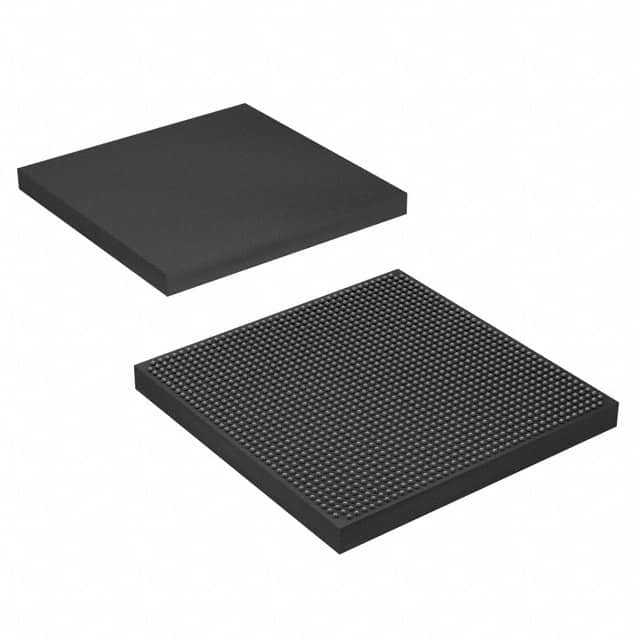Viz Specifikace pro podrobnosti o produktu.

5SGXMA4K2F40I2N
Product Overview
Category
The 5SGXMA4K2F40I2N belongs to the category of Field Programmable Gate Arrays (FPGAs).
Use
FPGAs are integrated circuits that can be programmed and reprogrammed to perform various digital functions. The 5SGXMA4K2F40I2N is specifically designed for high-performance applications.
Characteristics
- High-performance FPGA with advanced features
- Large capacity and high-speed processing capabilities
- Flexible and reconfigurable design
- Suitable for complex digital systems
Package
The 5SGXMA4K2F40I2N comes in a compact package, ensuring easy integration into electronic systems.
Essence
The essence of the 5SGXMA4K2F40I2N lies in its ability to provide a customizable and powerful digital processing platform for a wide range of applications.
Packaging/Quantity
The 5SGXMA4K2F40I2N is typically packaged individually and is available in various quantities depending on the customer's requirements.
Specifications
- FPGA Family: Stratix V
- Logic Elements: 462,000
- Embedded Memory: 14,062 Kbits
- DSP Blocks: 1,288
- Maximum User I/Os: 1,280
- Operating Voltage: 1.0V
- Operating Temperature: -40°C to 100°C
- Package Type: F40
- Package Pins: 1517
Detailed Pin Configuration
For a detailed pin configuration diagram of the 5SGXMA4K2F40I2N, please refer to the manufacturer's datasheet or documentation.
Functional Features
- High-speed data processing capabilities
- Support for various communication protocols
- On-chip memory for efficient data storage
- Flexible I/O interfaces for easy integration with external devices
- Advanced clock management features for precise timing control
Advantages and Disadvantages
Advantages
- High-performance FPGA suitable for demanding applications
- Reconfigurable design allows for flexibility in system development
- Large capacity enables complex digital designs
- Support for various communication protocols enhances compatibility
Disadvantages
- Higher cost compared to other programmable logic devices
- Steeper learning curve for programming and utilizing the full potential of the FPGA
- Requires additional design effort for optimal performance
Working Principles
The 5SGXMA4K2F40I2N operates based on the principles of reconfigurable logic. It consists of a matrix of configurable logic blocks interconnected through programmable routing resources. The user can program the FPGA to implement desired digital functions by configuring the interconnections and functionality of the logic blocks.
Detailed Application Field Plans
The 5SGXMA4K2F40I2N finds applications in various fields, including: 1. Telecommunications: High-speed data processing for network infrastructure equipment. 2. Aerospace and Defense: Radar and signal processing systems. 3. Industrial Automation: Control systems for manufacturing processes. 4. Medical Imaging: Real-time image processing for medical diagnostic equipment. 5. High-Performance Computing: Acceleration of computationally intensive tasks.
Detailed and Complete Alternative Models
Some alternative models to the 5SGXMA4K2F40I2N include: 1. Xilinx Virtex UltraScale+ VU9P 2. Intel Stratix 10 GX 2800 3. Lattice ECP5-85 4. Microsemi PolarFire FPGA 5. QuickLogic EOS S3
These alternative models offer similar capabilities and can be considered based on specific project requirements.
Word count: 520
Seznam 10 běžných otázek a odpovědí souvisejících s aplikací 5SGXMA4K2F40I2N v technických řešeních
Sure! Here are 10 common questions and answers related to the application of 5SGXMA4K2F40I2N in technical solutions:
Q: What is the 5SGXMA4K2F40I2N FPGA used for? A: The 5SGXMA4K2F40I2N is a Field-Programmable Gate Array (FPGA) that can be used for various applications such as high-performance computing, networking, and signal processing.
Q: What are the key features of the 5SGXMA4K2F40I2N FPGA? A: Some key features include a large number of logic elements, high-speed transceivers, embedded memory blocks, and support for various communication protocols.
Q: Can the 5SGXMA4K2F40I2N FPGA be used for real-time video processing? A: Yes, the FPGA's high-performance capabilities make it suitable for real-time video processing applications like video encoding, decoding, and image recognition.
Q: Is the 5SGXMA4K2F40I2N FPGA suitable for high-bandwidth networking applications? A: Absolutely, the FPGA's high-speed transceivers and support for communication protocols like Ethernet and PCIe make it ideal for high-bandwidth networking solutions.
Q: Can the 5SGXMA4K2F40I2N FPGA be used for implementing cryptographic algorithms? A: Yes, the FPGA's ability to perform parallel processing and its support for encryption algorithms make it well-suited for implementing cryptographic solutions.
Q: Does the 5SGXMA4K2F40I2N FPGA support multiple I/O standards? A: Yes, the FPGA supports various I/O standards such as LVDS, SSTL, and HSTL, allowing for compatibility with different interfaces.
Q: Can the 5SGXMA4K2F40I2N FPGA be used in safety-critical applications? A: Yes, the FPGA can be used in safety-critical applications by implementing redundancy, fault tolerance, and other safety mechanisms.
Q: What development tools are available for programming the 5SGXMA4K2F40I2N FPGA? A: Intel Quartus Prime is the recommended development tool for programming and configuring the 5SGXMA4K2F40I2N FPGA.
Q: Is the 5SGXMA4K2F40I2N FPGA suitable for high-performance computing (HPC) applications? A: Yes, the FPGA's large number of logic elements and high-speed capabilities make it well-suited for HPC applications like scientific simulations and data analytics.
Q: Are there any reference designs or application notes available for the 5SGXMA4K2F40I2N FPGA? A: Yes, Intel provides reference designs and application notes that can help developers get started with implementing solutions using the 5SGXMA4K2F40I2N FPGA.
Please note that the specific details and answers may vary depending on the context and requirements of the technical solution.

